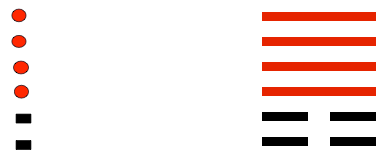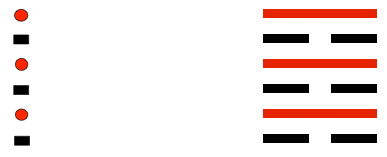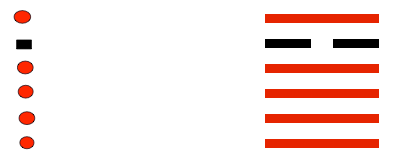|
The Process
There are three ways to determine the Hexagram inherent in any creative experience. These
are by choosing a card, flipping coins or counting the stalks of the yarrow plant. The card method is
limited in that it does not reveal changing lines. The coin method is effective and quick. The stalk
method is preferred due to the mechanics and thought processes involved. The material is the same for
all three methods. The first step in the sequence assumes the coin or stalk methods are in use.
First, build your Hexagram. In both the coin and stalk methods, it is suggested that the six
lines of Hexagram #1, Chi'en, Creative Spirit are contemplated prior to the flipping or counting of that line.
In the traditional technique, the practioner faces south when consulting the oracle. This is the direction
of the sun, so in the southern hemisphere, a counting or flipping would be performed facing north.
Stalk countings can become quite elaborate in their spiritual rituals. A counting space or altar can be
used which houses items of special significance representing both Yang and Yin energy. Gongs or
bells are sounded to announce the beginning of the process. The resulting Hexagrams can be kept
in a journal with the lines brushed in ink. This journal can also record the changing weeks of the year
and the Inner Circle Hexagrams corresponding to the calendar.
A specific question may be asked prior to the process, but it is not required. If asked, it is
suggested that the question be asked out loud, piercing the resistances inherent between spirit and ego.
Please see Chapter #6 - "The Coin and Stalk Methods" for a review of the flipping or counting procedure.
A blank worksheet and three basic examples are provided in the following pages.
Second, record and contemplate the name and the idea of the Hexagram. These ideas are
outlined in "The Table of Ideas" exhibit. Please note the order of the table. Each Hexagram in a row has
the identical bottom Trigram. All of the bottom Trigrams of the first row contain three solid lines. This
Trigram is Chi'en, Creative Spirit and the ideas of the top row are the creative ideas of Spirit. The bottom
Trigram of each of the succeeding rows follows the order found in the exhibit "The Trigrams - The Eight
Aspects of the Creative Spirit" in chapter #2. That order again is Chen - the ideas of Spiritual Power,
K'an - ideas of the Divine Path, Ken - ideas of the Present Moment, Sun - ideas of creative Development,
Li - ideas of Spiritual Awareness, T'ui - ideas of sublime Joy and K'un - ideas of the creative Manifestation.
This order also holds for the columns. The top Trigram of each Hexagram in the first column
is also Chi'en, Creative Spirit. The second column Hexagrams all have the Trigram Chen - Power as
their top Trigram. The columns continue with the top Trigram of each Hexagram reflecting this same order.
Third, contemplate the four Trigrams of the Hexagram in the following sequence:
1. - Lower Primary Trigram
2. - Upper Primary Trigram
3. - Lower Nuclear Trigram
4. - Upper Nuclear Trigram
Notice how they fit together. Creative energy flows through these patterns from bottom to top.
The degree of influence is represented by this sequence. To illustrate this idea, let's look at the first
worksheet example, Hexagram #14, Will. The lower primary Trigram is Chen, Power. The upper
primary Trigram is Chi'en, Creative Spirit. The idea of the Hexagram is then the Power of Spirit. We have
discussed however that the true flavor of the Hexagram is determined by also examining the nuclear
Trigrams and adding their characteristics to the whole. In Hexagram #14, the bottom nuclear Trigram
is Ken, the Present Moment and the top nuclear Trigram is Sun, Development. For a full discussion
of primary and nuclear Trigrams please see the previous chapter "The Three Stages of Change of Yang
and Yin". The nuclear Trigrams now added to the primary Trigrams in the order suggested above results
in the full idea of Hexagram #14, the Power of Spirit experienced through Present Moment Development.
That then is the idea of creative Will, the power of the divine creative spirit experienced in the present
moment through the development of our grandest choices and most creative visions.
Let's look at our second example, Hexagram #43 - "Understanding". The lower primary
Trigram is again Chen, Power. The upper primary Trigram is Li, Awareness. The central idea of the
Hexagram is the Power of Awareness. Adding the lower nuclear Trigram of Ken, the Present Moment
and the upper nuclear Trigram K'an, the Path, the full idea of Understanding as it relates to the Creative
I Ching is the Power of Awareness experienced in the Present Moment on the Divine Path.
The third example is Hexagram #34, "Optimism". Using the two primary trigrams, the idea
of the Hexagram is the Joy of Awareness. Adding the two nuclear Trigrams gives us the complete
idea, the Joy of Awareness experienced through Awareness of the Divine Path. When there is a doubling
of Trigrams as in this case (both the upper primary Trigram and the lower nuclear Trigram are the same,
Li - Awareness) the idea of continuing experience comes into consideration. The alternative idea for
Hexagram #34 - "Optimism" is the Joy of the continuing experience of Awareness on the Divine Path.
Fourth, determine and contemplate the Hexagram number and its position in the Sequence
of creative experience. Is your Hexagram in the Inside Circle, Inner Circle or Outer Circle? What place
in that circle does it occupy and what does that infer?
To determine the Hexagram number, consult the exhibit "The Chart of the Order". Your bottom
Trigram is listed on the left in the order established in the exhibit "The Trigrams - The Eight Aspects of
the Creative Spirit" in chapter #2, and the top Trigram occupies the same order along the top of the exhibit.
The intersection of these two Trigrams reveals the Hexagram number. Your Hexagram can then be
located on the exhibit "The Chart of the Sequence" in Chapter #4. "The Hexagrams, the Sequence and
the 10,000 Things" to determine its position. That exhibit will refer you to one of the following exhibits
based upon whether your Hexagram is in the Inside Circle or Inner Circle, or in one of the four Houses
of the Outer Circle. If the Hexagram is one of the four Hexagrams of the Inside Circle, it reveals a core
element of reality. If it is one of the eight Inner Circle Hexagrams, it is a fundamental archetype of the
path of creative energy manifesting from the divine field of potential through the metaphysical universe
into the physical universe. All 52 of the Outer Circle Hexagrams reflect a specific facet of the physical
universe itself. The relative position of all 64 Hexagrams can be found on the appropriate exhibit in
Chapter #2 in the "Sequence" section.
Using our first example, Hexagram #14, "Will" is in the Outer Circle. It resides in the House
of Conception and it is one of the first three Hexagrams of that House. It's sequence as outlined in the
exhibit for the House of Conception in Chapter #4 is "The middle of the experience of conception".
Hexagram #43, "Understanding" is in the House of Compassion. As the 5th Hexagram in that
House, its sequence is "The Middle of the Creation of Compassion". Hexagram #34, "Optimism"
is in the House of Creation with the sequence "The Middle of the Compassion of Creation".
The meaning of the Hexagram's position within the sequence becomes more apparent with
practice. A Hexagram in the conception of a House describes good energy for a new beginning, whereas
a Hexagram in the compassion of a House is more celebratory. An Outer Circle Hexagram relates
to the physical universe, where an Inner Circle Hexagram is more fundamental and formative.
Fifth, contemplate the change. The I Ching is uniquely capable of revealing the energy
pattern inherent in any creative experience, and if one of the lines obtained is moving (either an "old Yang"
or "old Yin" line) it can also discern the quality of energy in upcoming experiences. For an explanation
of moving lines, please see the previous chapter "The Three Stages of Change of Yang and Yin".
The idea is that when a full line is obtained, it is in process of the naturally occurring change into its
contrasting element, Yang into Yin or Yin into Yang. This change results in a new Hexagram revealing
a future energy pattern and allowing for a smooth transition of the practitioner through the change.
Let's again turn to our three examples. In Hexagram #14, "Will" we have a 9 or moving
"old Yang" in both the 4th and 6th lines. These will change into contrasting Yin lines in the new
Hexagram. The upper primary Trigram changes from Chi'en, Creative Spirit into K'an, the Path. The
new Hexagram then becomes #59 - "Experience". The idea of "Experience" is the Power of the Path
experienced through the Manifestation of the Present Moment.
Hexagram #43, "Understanding" has a moving 9 in the 4th line. This "old Yang" changes into
a contrasting Yin line and the top primary Trigram moves from Li - "Awareness" into Ken - "the Present
Moment". The Hexagram changes into #5, "Potential", the Power of the Present Moment experienced
through the continuing Manifestation of our grandest choices and most creative visions.
Hexagram #34, "Optimism" has a moving 9 in the 2nd line. Changing into Yin, the lower
primary Trigram now becomes Chen - "Power" and the resulting Hexagram is #43 "Understanding".
This is our second example with the idea "The Power of Awareness experienced in the Present Moment
on the Divine Path.
Of course, if no moving lines were obtained in building the Hexagram, then the current
pattern reveals a steady and continuing situation.
Sixth, contemplate the Full Lines. Each moving Yang line carries with it the image and quality
of the corresponding line of Hexagram #1 - "Chi'en - Creative Spirit". Every moving Yin line embodies
the characteristics and results of the corresponding line of Hexagram #2 - "K'un - Existence".
A summary of the Yang images and qualities and the Yin characteristics and results can
be found in the two exhibits in the previous chapter "The Three Stages of Change of Yang and Yin".
So, in our first example, Hexagram #14, "Will", the 9 in the 4th corresponds with the 4th
line of Hexagram #1 - "Chi'en - Creative Spirit". Summarizing that line from the exhibit in the last
chapter, "Dragons in steady flight, sincere and joyous, advancing with success". The 9 in the 6th
carries the image of "Dragons inspiring creation" and the qualities of "Modesty, sincerity and joyousness".
Our second example, Hexagram #43, "Understanding" also has a moving 9 in the 4th line
with the image of "Dragons in steady flight" and the qualities of "Sincerity and Joyousness, advancing
with success".
Our last example, Hexagram #34, "Optimism" has a moving 9 in the 2nd position. That
image from Hexagram #1 is "Dragons appearing in the meadows" with the qualities of "Sincerity and
following Divine Truth".
In addition to its relationship with Hexagrams #1 and #2, each moving line reveals its stage
of change within each of the Trigrams that it resides. This is also explained in the previous chapter.
The meaning of each Full Line expands by contemplating its place within the primary and nuclear
Trigram sequence. Apply the three stages of change in the following sequence:
1. - Lower Primary Trigram
2. - Upper Primary Trigram
3. - Lower Nuclear Trigram
4. - Upper Nuclear Trigram
Moving lines in the 1st and 6th positions are only in one Trigram. A moving line in the 1st
is the bottom line of the lower primary Trigram and a moving line in the 6th is the top line of the upper
primary Trigram. You can see on the Worksheet that there is only one line to describe the stage of
change for a moving line in the 1st and the 6th positions. A moving line in the 2nd and 5th positions are
in two Trigrams of the Hexagram. A moving line in the 2nd is both the middle line of the lower primary
Trigram and the bottom line of the lower nuclear Trigram. A moving line in the 5th is both the middle line
of the upper primary Trigram and the top line of the upper nuclear Trigram. Note on the Worksheet that
there are two lines for the stages of change for a moving line in the 2nd and 5th positions.
Moving lines in the 3rd and 4th positions are in three Trigrams each. A moving line in the 3rd
is the top line of the lower primary Trigram, the middle line of the lower nuclear Trigram and the bottom
line of the upper nuclear Trigram. A moving line in the 4th is the bottom line of the upper primary
Trigram, the top line of the lower nuclear Trigram and the middle line of the upper nuclear Trigram.
There are three lines to describe the stages of change for moving lines in the 3rd and 4th positions.
Let's look at our three examples one final time. In Hexagram #14, "Will", the 9 in the 4th is
in three of the Hexagram's Trigrams. It is the bottom line of the upper primary Trigram Chi'en - "Spirit".
It is the top line of the lower nuclear Trigram Ken - "Present Moment", and it is the middle line of the
upper nuclear Trigram Sun - "Development". From the "Table of Trigrams" in the previous chapter, we
define the stage of change of the 9 in the 4th in each Trigram. As the bottom line of the upper Trigram
it is in the stage of "Creativity" and is identified as "Creative in Spirit". As the top line of the lower
nuclear Trigram it is in the stage of "Inspiring" and is identified as "Inspiring the Present Moment".
As the middle line of the upper nuclear Trigram it is in the stage of "Furthering" and is identified as
Furthering in Development. The 9 in the 6th is only in one Trigram, it is the top line of the upper primary
Trigram of Chi'en - "Spirit" and so is identified as "Inspiring in Spirit".
The 9 in the 4th position of Hexagram #43, "Understanding" is in three Trigrams. As the
bottom line of the upper primary Trigram, the line is "Creative in Awareness". As the top line of the
lower nuclear Trigram it is "Inspiring in the Present Moment" and as the middle line of the upper nuclear
Trigram it is identified as "Furthering on the Divine Path".
The 9 in the 2nd position of Hexagram #34, "Optimism" is in two Trigrams. It is the middle
line of the lower primary Trigram with the stage of change of "Furthering in Joy". It is also the bottom
line of the lower nuclear Trigram, "Creative in Awareness".
In summary, the Process is:
First. Build the Hexagram.
Second. Contemplate the name and idea of the Hexagram using "The Table of Ideas".
Third. Contemplate the Trigrams.
Fourth. Contemplate the sequence using "The Chart of the Order" and "The Chart of the Sequence".
Fifth. Contemplate the Change.
Sixth. Contemplate the Moving Lines using the exhibits "The Yang Line Images and Qualities" and
"The Yin Line Characteristics and Results". Determine the stage of change within
each Trigram using the "Table of Trigrams".
Advanced Practice and the Internal Hexagrams
The advanced practice is for yarrow stalk countings only. In building a Hexagram with the
stalk method, three groups of stalks are counted for each line obtained. A group of 4 stalks has the
value of 3 and a group of 8 stalks has a value of 2. The group of 4 is considered a Yang group and
a group of 8 is considered a Yin group. I like to visualize these groups as red balls and black boxes,
the balls being Yang and the boxes being Yin. Each line becomes a series of balls and boxes that
eventually build the final picture of the Hexagram.

When these balls and boxes are recorded during the counting process, they reveal a hidden
set of three Hexagrams that I call the Internal Hexagrams. In the first example used in this chapter,
Hexagram #14, "Will" was counted. The following picture represents the balls and boxes obtained
during the process.

These balls and boxes, when turned sideways, reveal that they are actually only the ends
of solid and broken lines that are perpendicular to the counting plane. Visually, it looks like this. The
first column of balls and boxes reveals the Internal Hexagram #11 - "Wonder".

The second column of balls and boxes reveals the Internal Hexagram #3 - "Before Completion".

The third column of balls and boxes reveals the Internal Hexagram #8 - "Wisdom".

The full image of this Hexagram including the Internal Hexagrams goes like this:
"The Power of the Creative Spirit experienced through Present Moment Development.
Before Completion is surrounded with Wonder and Wisdom".
An investigation of these Internal Hexagrams reveals a new world of understanding for all
Hexagrams obtained through the stalk counting method. A master practitioner can perform a counting
and keep all the balls and boxes in memory until recording them at the end of the counting process.
Practicing this memorization and the recognition of the Internal Hexagrams prior to writing them down
is an excellent awareness expanding exercise.
|